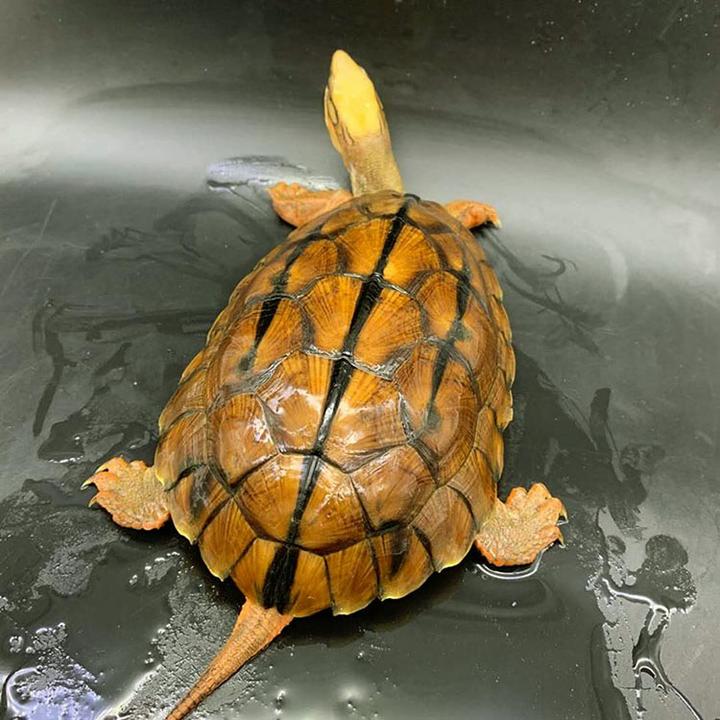Variety Overview
English Name: Cuora trifasciata
Also Known As: Red-edged Turtle, Red-bellied Turtle, Broken-board Turtle, Golden-headed Turtle
Origin: Qinzhou City, Guangxi Zhuang Autonomous Region
Weight: Approximately 1.25-1.5 kg (2.5-3 lbs)
Height: 15-20 cm (6-8 inches)
Lifespan: 30-80 years
The golden coin turtle (Cuora trifasciata) features a relatively slender head with a smooth top devoid of scales. Its snout is blunt with a slightly hooked upper beak. Its throat and neck exhibit a light orange-red color, while rhomboid brown patches can be found behind its eyes on both sides of its head. The back of its head is wax yellow, and its carapace (upper shell) is reddish-brown adorned with three black longitudinal stripes resembling the Chinese character “川”, with the central stripe being longer (absent in juveniles). Both front and rear edges of its carapace are smooth without serrations. Its plastron (lower shell) is black with yellow edges; ligaments connect the carapace to the plastron as well as between pectoral and abdominal shields, enabling complete closure of its shell. The skin around its armpits, limbs, and tail is orange-red. It has webbed fingers and toes along with a short pointed tail.
The golden coin turtle breathes through lungs and leads an amphibious lifestyle both in water and on land. It predominantly resides in gorges, small streams, river branches, and lakes within mountainous or hilly regions but occasionally ventures into damp mountain ravines, grasslands, or rice fields for activity. On sunny days it enjoys basking on land; however, during hot weather it prefers hiding in dark places. This species tends to live communally or in burrows.

Development Origin
The golden coin turtle (Cuora trifasciata) is primarily found in China’s Guangdong, Guangxi, Hainan, Fujian provinces, and Hong Kong, as well as in Southeast Asian countries like Vietnam and Laos. Classified as a second-tier protected species in China, this turtle is highly valued for its medicinal properties, ornamental appeal, craftsmanship potential, culinary uses, and importance in modern scientific research. The increasing demand for the golden coin turtle has led to a decline in their natural population due to their low reproduction rate and excessive hunting by humans. As a result, it has become increasingly rare to spot these turtles in the wild.
Ideal Audience
The golden coin turtle is ideal for individuals with large-scale turtle farming operations. As a second-class protected species in China, raising this turtle requires obtaining a “License for Domestication and Breeding of Aquatic Wild Animals” from local fisheries authorities (e.g., the Fisheries Bureau) or partnering with an established large-scale turtle farm; otherwise, it would be deemed illegal. Known for its gentle nature, the golden coin turtle symbolizes wealth, longevity, and good fortune. Additionally, its ease of care makes it an excellent choice for a household pet.

Feeding Guidelines
Golden coin turtles thrive in relatively clean water conditions. In artificial breeding setups, these turtles often reside in confined spaces where leftover food and waste can quickly pollute the water. Prolonged exposure to poor water quality can cause issues like shedding skin, eye infections, and loss of appetite. Despite this, golden coin turtles are fairly resilient when it comes to water conditions; with an appropriate filtration system, regular water changes, and balanced feeding practices, their growth needs are typically met. Important water quality parameters include ammonia nitrogen, nitrite nitrogen, pH level, hydrogen sulfide, and suspended solids. Compared to fish, turtles have lower demands for water quality; any water suitable for fish is usually good enough for turtles too. However, it’s crucial to consider the variations in water quality across different regions when breeding turtles elsewhere, particularly concerning pH levels.
